Gap basics
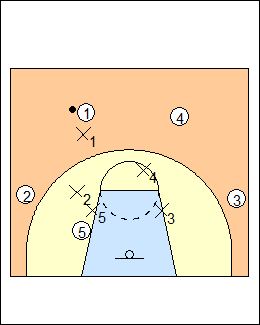 | 1 See Defences - Gap, Pack line, Petitgoue youth. One defender pressures the ball, the other four defenders protect the paint (shrink the floor on defence). X1 contains the ball out top and forces weakhand, X2 and X4 are in the gaps, X3 is in a help (sight) position, one foot in the paint, post defender X5 is on-the-line, up-the-line (no post entry from the top). Gap defenders are already in position to help (move laterally), then recover. Optionally use a closed stance to see ball and man, and to open up on a drive. Don't help "up", or pivot to lose sight of your check. Do shell drill, then optionally go live on a specified offensive action, e.g., a post entry, or drive and kick. Dick Bennett - basketball is now more north-south than east-west (motion), players try to get into the paint, drive and kick for 3s. Pack (gap) defence really makes it hard to get the ball into the paint. He had success getting into "push" (pressure) defence when the ball is on a side (force baseline, deny reversal). |
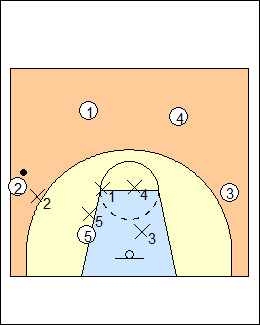 | 2 With the ball on the wing, X2 does not give up baseline penetration (her baseline foot is outside 2's baseline foot) and takes away a baseline post-entry pass. If 2 jabs right, X2 pops back and splits the jab foot. X1 gaps, X4 and X3 are sight defenders (a weakside "i"), Post defence a) Gold (deny) X4 plays 5 on the high side (3/4), and is already up the line if 2 passes to 1, preventing a duck-in. You give up rebounding position if fronting. Mike Jones - they have a long X5 who can block shots, and want him to just stay behind 5. coachesclipboard.ca - with the international lane, many teams defend a low-post attacker from behind because fronting is very vulnerable to lob passes. Jack Bennett - you may have to front for a two-count if he backs you down into the lane. |
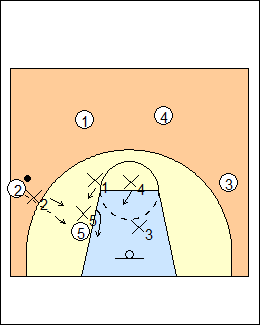 | 3 Guard the post "3/4 to behind" - on a post entry, X5 jumps behind on air time, gaps off, and takes away baseline. Perimeter players choke on the post, then can dig (up) with one hand on a dribble, and recover if the dribble is picked up. See Defending - Fratello 4-player close-outs, Pasquali post, Wootten 2 on 2 one side, Villanova 2 on 2 in the post, Danny Manning post, Defence - Petitgoue youth. Variation - X5 takes away middle, e.g. if 5 is close to the baseline. Kevin O'Neill - if 5 gets the ball with X5 behind, X5 has a no-middle stance. Gord Herbert - X5 doesn't allow middle penetration, and forces below the backboard if 5 goes baseline. Pasquali - if 5 gets the ball close to the baseline, force him to dribble baseline, help comes from the weakside. |
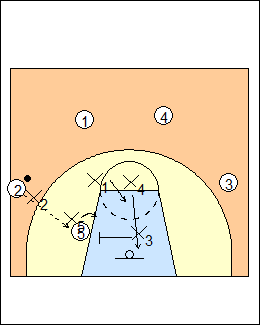 | 4 b) Red (front) X5 fronts 5, sitting on her top leg (e.g., if 5 has a foot in the paint) and calling "red" or "early" so that X2 pushes up hard into the ball, and X3 is ready to help on a lob pass (steal, take a charge). On a post entry, X5 front (or reverse) pivots on her top (right) foot to take away middle, bottom-of-the-i X3 double-teams on the baseline side. X4 sinks and X1 fills. Options - front the low post if the ball goes to the corner (even with or below X5) - red the post only once in a possession. Dick Bennett - when dead-fronting the post, go underneath to rebound on a shot, you can seal him out. |
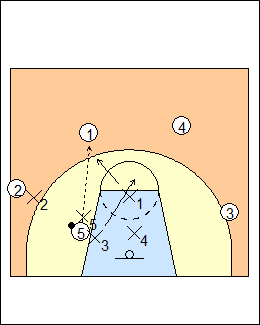 | 5 X2 denies a return pass, X1 and X4 zone up in the paint, X4 takes a pass to 3, X1 takes first pass to 1 or 4, X3 rotates to the open player (has leftovers), X5 stays with 5. O'Neill - don't red if 5 moves out, gold from the high side, force him baseline. See Defence - Kevin O'Neill, Defending - 4 on 1 post. |
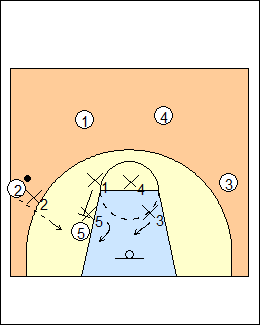 | 6 c) X (double-team) Allow a post entry from the wing. X5 plays behind 5, or gets behind 5 as the pass is in the air, and takes away the baseline. X2 denies a return pass to 2. If trapping from the elbow (a 2X trap), X1 comes down to double-team, taking away middle. Variation - use a designated trapper, e.g. the other big, or off a dead match-up. If X2 is the trapper, X1 would rotate to deny a pass back to 2. Sean Miller - help always comes from the top (choke, dig, trap). |
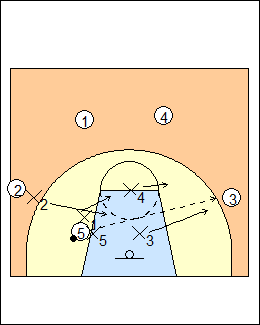 | 7 X2 denies a return pass, X4 and X3 zone up in the paint, X3 takes a pass to 3, X4 takes first pass to 1 or 4, X1 rotates to the open player, X5 stays with 5. See Defending - Pistons innings, 5 on 5 shell double-down, Tubby Smith 4 on 4 overplay, Defences - Post double-teams, Tar Heels pressure, Mavs, Kentucky ball-line. |
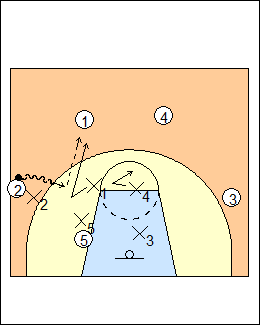 | 8 Dribble penetration X2 does not give up a middle drive below the elbow (level the ball), X1 helps (stunts at the ball, keeping vision of 1) then recovers on the kick-out pass to 1, X4 stunts to help X1 on the pass to 1, then recovers. Mike Fratello - X4 stunts when X1 stunts, X4 and X1 are tied together on a string. X5 does not help on dribble penetration. If 2 beats X2 on the baseline, bottom-of-the-i X3 helps and X4 covers down, see below. Greg Francis - he wants X5 to show on baseline penetration with a ballside post, other defenders shrink the floor, everyone recovers to the their own checks. See Defending - Pitt 4 on 4 penetration, Fratello 3 on 3 drive and kick, Forcing left shell, Defence - Forcing left basics. |
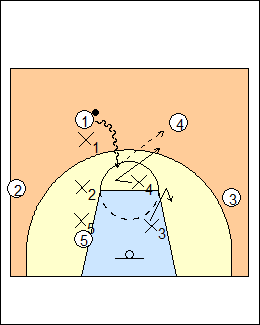 | 9 If 1 drives middle, X4 helps (stunts at the ball, keeping vision of 4), X3 stunts at 4 on the kick-out pass (to help X4), X4 and X3 recover. See Defending - Wootten horseshoe. |
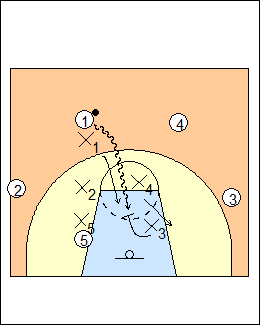 | 10 If 1 beats X1 and X4 to the middle (or beats X1 and X2 to the outside), X3 is the help and X4 covers down to help the helper. |
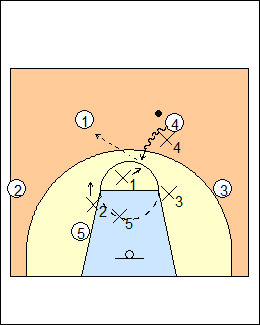 | 11 X4 forces weakhand, X1 and X3 are in the gaps, X2 is a sight defender, X5 is above 5 in a closed stance to smash a flash. If 4 drives middle, X1 helps, X2 stunts at 1 on a kick-out pass (shown, then X1 and X2 recover), or helps if 4 beats X4 and X1, and X1 covers down to help the helper. In a game, 1 may pass to 4 and basket cut, clearing out gap defender X1. |
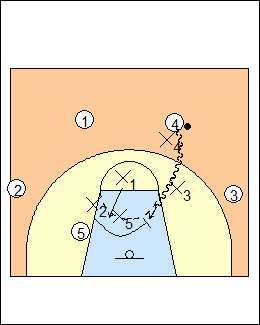 | 12 X2 also helps if 4 beats X4 and X3 to the outside, and X1 covers down. A similar situation could happen if X3 does not help off a shooter in the corner, or in transition where the defence is not yet set. See Defending - 4 on 3 cover down, DeMatha shell. |
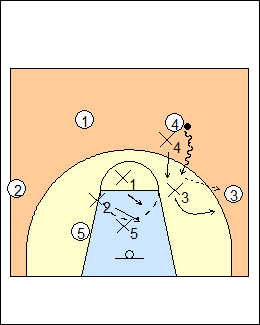 | 13 Here gap defender X3 helps and recovers on a pass to 3, and takes away a baseline drive by stepping toward the baseline then closing out. X2 moves low toward the ball. See Defending - 3 on 3 kick-out. |
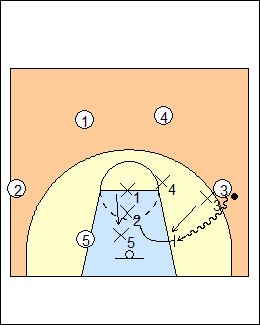 | 14 X4 gaps, X1 and X2 are sight defenders. If 3 beats X3 to the baseline, X2 helps, X1 covers down (shown). Greg Francis - X4 rotates to the top of the "i", X3 peels off looking for the next player in that direction when X2 calls "switch". X5 does not help. See Defence - Help rotations. |
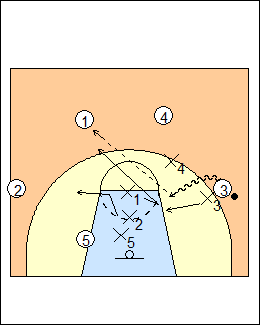 | 15 If 3 beats X3 and X4 to the middle, top-of-the-i X1 helps (take away a layup), and recovers on a pass to 1, X2 stunts to help the helper. X3 should level off the drive, above the elbow. A three-man rotation may be needed e.g. if 1 is spaced away or X1 loses vision. X1 calls "help" or "switch" and stays with 3, X2 takes first pass, X3 peels off and has leftovers. If X2 helps on the drive and X1 covers down, 1 may be wide open. Ernie Woods - high weakside X1 stops middle penetration, if a low defender steps up it creates an easy passing lane to his man. Greg Francis - when you help off the help side on middle penetration, it's a very easy pass for most players if the offence maintains good spacing, and it creates a scramble situation to recover on a quick pass-pass (here to 2).. In a game, 4 may pass to 3, basket cut, and exit weakside or ballside, clearing out gap defender X4. Option - have 4 pass to 3 and basket cut, go live on a middle drive and kick. Greg Francis - if 4 is in the ballside corner, X1 calls switch if help is required on the drive, X2 covers first pass, X4 has second pass, and X3 drops to cover 4 in the corner. |
This page was made with Basketball playbook from Jes-Soft
